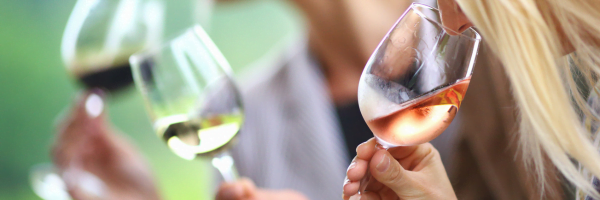See, swirl, sniff, sip, savor. A 20 point scoring system for judging wine.
Appearance, see and swirl (3)
- Clarity – bright, dull, bitty, hazy, cloudy, sediment
- Intensity – Colorless, pale, medium, dark, opaque
- Color
- White – green, yellow/green, yellow, straw, yellow/gold, gold, deep gold, amber, tawny, tuile, brown
- Red – purple, purple/red, ruby, red, red/brown, garnet, mahogany, brown
- Viscosity – slight sparkle, watery, normal, heavy, oily
Aroma/Bouquet, sniff (6)
- General – neutral, clean, attractive, outstanding
- Aroma – none, slight, adequate, positive, identifiable
- Bouquet – none, pleasant, complex, powerful
- Development – none, dumb, immature, well-developed
- Quality – poor, ordinary, good, fine, great, magnificent
Taste/Texture, sip (6)
- Intensity – light, moderate, pronounced or intense
- Texture – Oily creamy, CO2
- Sweetness – bone dry, dry, medium-dry, sweet, very sweet, heavy, syrupy
- Acidity
- Excessive – acid, green, tart, nervy, acetic
- Balanced – fresh, lively, supple, smooth
- Insufficient – flat, flabby
- Tannins – astringent, hard, dry, balanced, soft, rich
- Bitterness – low, medium, moderate, high
- Alcohol – light, sufficient, generous, heady, hot
- Body – meagre, thin, full, round, fat
- Development – green, beginning, mature, well developed
- Balance – unbalanced, good, very well balanced, perfect
Aftertaste (3) short, medium/moderate, long/lingering, extended
- Textures & Flavors
Overall, savor (2) poor, acceptable, good, very good, outstanding, excellent
- Balance, length of finish, intensity, complexity, typicity, flaws or faults
- Aesthetics – pleasant, unpleasant and why
Total Scores
Extraordinary (18-20), Excellent (15-17), Good (12-14), Marginal (9-11), Deficient (608)
Aromas
- Primary aromas are the fruity aromas of the wine that originate from the grape variety and the specific terroir the vines were grown in. Red wine usually has aromas of red and black fruit, while white wine has dominant citrus or tropical fruit aromas.
- Secondary aromas are a result of the fermentation and malolactic fermentation processes. They include specific yeast, mushroom, and earth smells that accompany the primary fruit aromas.
- Tertiary aromas develop during the wine aging process. These are more subtle scents that complete the aroma bouquet. For example, a wine aged in an oak barrel develops distinct toasty, nutty, or vanilla aromas.
Tastes
Sipping wine brings a focus on the balance of sweetness, acidity, alcohol and tannin, combined with an overall texture.
- Sweetness is one of the first sensations on your tongue. A wine’s residual sugar levels can be anywhere between 0 g/L (dry wine) to 220 g/L (sweet wine.)
- Acidity gives you clues on whether the grape vines were grown in a cold or hot climate and the wine’s aging potential. Less acidic wines have a smoother mouthfeel.
- Alcohol content can vary from 5% to 21% ABV. A dry wine would usually have a higher alcohol content, resulting in a warm sensation in your mouth, while a sweet wine, on the other hand, would have low alcohol content.
- Tannins are primarily present in red wine and impart an astringent taste and dry sensation in your mouth. Wines aged in oak barrel vessels usually have softer and rounder tannin levels. Young wine would have harsher tannin levels, while older wines have softer and rounder tannin mouthfeel.
- Texture of wine could also be full-bodied or light. A heavy wine with a high alcohol would have a fuller body, while wines with a low alcohol will be lighter. To understand the texture of the wine you’re tasting, just swirl it gently in your mouth and try to understand how it feels.
Descriptive Terms
Primary
- Floral – perfumed, iris, peony, elderflower, acacia, lilac, jasmine, honeysuckle, violet, lavender, rose, geranium, orange blossom, potpourri, hibiscus
- Citrus – lime, lemon, grapefruit, orange, marmalade
- Tree Fruit – apple, pear, peach, nectarine, apricot, persimmon, quince, prune
- Tropical Fruit – pineapple, mango, guava, kiwi, lychee, bubblegum, banana, melon
- Red Fruit – cherry, sour cherry, strawberry, raspberry, pomegranate, cranberry
- Black Fruit – blackberry, blueberry, boysenberry, black currant, black cherry, plum, olive
- Dried Fruit – raisin, fig, date, fruitcake
- Noble Rot – beeswax, ginger, saffron
- Spice – white red or black pepper, almond, cloves, chocolate, brown-sugar, caramel, cinnamon, anise, fennel, licorice, eucalyptus, mint, thyme
- Vegetable – hay, leaves, grass, tomato leaf, gooseberry, bell pepper, jalapeno, almond, tomato, sun-dried tomato, black tea
- Earth – dusty, clay pot, slate, wet gravel, potting soil, red beet, volcanic rocks, petroleum, tar, phenolic, medicinal
Secondary
- Microbial – butter, cream, sourdough, lager, truffle, mushroom, yeast
Tertiary
- Oak Aging – vanilla, coconut, baking spices, cigar box/cedar, toast, smoke, dill
- General Aging – dried fruit, nuts, tobacco, coffee, cocoa, leather
Faults
- Corked – musty cardboard, moldy, wet dog
- Mercaptans & Sulfides – cured meat, boiled eggs, burnt rubber, match box, garlic, onion, cat piss
- Brettanomyces – excess yeast, black cardamom, band-aid, sweathy leather saddle, horse manure
- Cooked – toffee, stewed fruit
- Volative Acidity – vinergar, balsamic
- Tannins – inky, silky, leathery, musty, sweaty
- Balance – Xs acid, Xs sugar, Xs tannin, Xs alcohol
- Abnormal Odors – yeast, oxidized, corky, woody, sulfur, phenolic, mousey, mercapten, beery, cidery,
- Terroir – nonexistent, faint, noticeable, marked
- Sickness – grease, turned, aldehyde, sweet, sour, rancid, lactic, bitter, burning, salty, sappy, watery, resinous, carbonated, stewed
- Accident – stagnant, mold, woody, corky, metallic, acrid, herb
Watch out for these
- A musty or moldy smell indicates a “corked wine” or a wine contaminated by cork taint (due to musty aroma compounds.)
- A burnt matches smell means the presence of sulphur dioxide during bottling and usually disappears after a short period of aeration.
- A nail polish or vinegar smell is volatile acidity in wine (an unpleasantly acidic wine.)
- A yeasty smell caused by the Brettanomyces yeast which may impart a hint of earthy scents to the wine in small amounts, but it can become unpleasant if too much.

